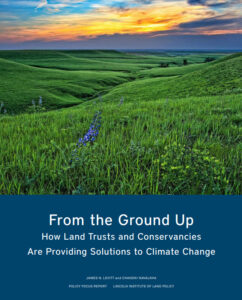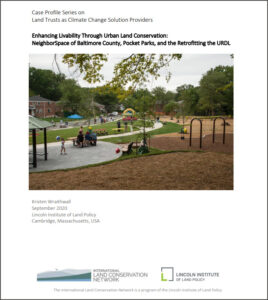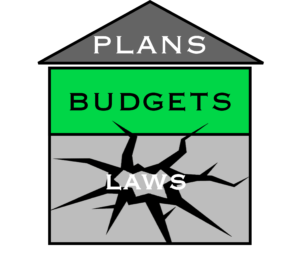Collaborating effectively is a key success factor for land trusts and conservancies aiming to achieve ambitious goals …. In Baltimore, the diverse regional partnerships that NeighborSpace forged with Morgan State University, local landscaping businesses, and local nonprofits through the Baltimore County Green Alliance served to mobilize volunteers, generate funding through open space fees, and build community support for park sites. (Lincoln Institute of Land Policy. From the Ground Up (Feb. 2022), pp. 56-57).
 So wrote the Lincoln Institute of Land Policy in a new report, From the Ground Up: How Land Trusts and Conservancies Are Providing Solutions to Climate Change, released last week. What is the Lincoln Institute? It is an internationally-recognized think tank, founded in 1946 and based in Cambridge, Massachusetts, which seeks to improve quality of life through the effective use, taxation, and stewardship of land. To fulfill this mission, it researches and recommends creative approaches to land use and management as a solution to economic, social and environmental policy challenges.
So wrote the Lincoln Institute of Land Policy in a new report, From the Ground Up: How Land Trusts and Conservancies Are Providing Solutions to Climate Change, released last week. What is the Lincoln Institute? It is an internationally-recognized think tank, founded in 1946 and based in Cambridge, Massachusetts, which seeks to improve quality of life through the effective use, taxation, and stewardship of land. To fulfill this mission, it researches and recommends creative approaches to land use and management as a solution to economic, social and environmental policy challenges.
1. BACKGROUND
The report presents excerpts from a dozen case studies, including one focused on the work of NeighborSpace, that show how land trusts and other nonprofits have meaningfully addressed climate change over the past several decades. It covers a broad geography, from China, to South America, Australia, Germany, the State of Vermont, Marin County, California and Baltimore County, Maryland. The organizations range in size from those with a national or international focus, like Greening Australia and the Nature Conservancy, to those with a narrower purview, like the Vermont Land Trust and NeighborSpace. By almost any measure, NeighborSpace is small fish in this report’s veritable ocean of much larger ones.
 The original case studies represented in From the Ground Up and compiled between 2018 and 2021 were also released to the public last week, including, Enhancing Livability Through Urban Land Conservation: NeighborSpace of Baltimore County, Pocket Parks, and the Retrofitting the URDL. Together, the reports provide important and timely findings and recommendations that can aid the ongoing debate about open space laws and policy in Baltimore County. Let me explain.
The original case studies represented in From the Ground Up and compiled between 2018 and 2021 were also released to the public last week, including, Enhancing Livability Through Urban Land Conservation: NeighborSpace of Baltimore County, Pocket Parks, and the Retrofitting the URDL. Together, the reports provide important and timely findings and recommendations that can aid the ongoing debate about open space laws and policy in Baltimore County. Let me explain.
2. FINDINGS
The researchers presented findings related to the transferability of the NeighborSpace model, the importance of collaboration between NeighborSpace and other organizations, especially County Government, the constraints faced by local government in replicating what NeighborSpace does, co-benefits of land conservation, and the importance of consistent funding from government. Each of these will be discussed, in turn.
A. Transferability
Among the conclusions reached by the researchers is the idea that the NeighborSpace model is broadly transferable to other urban areas: “The project, which has had positive initial response, may be adapted to inform land conservation in cities around the globe, from Latin America to Asia.” (Enhancing Livability, Case Overview).
B. Collaboration
Perhaps an even more important finding has to do with the value of land trusts as effective collaborators, especially with the public sector:
[N]imble civic organizations working with private interests, academics, other NGOs, and the public sector can devise effective solutions from the very small to the exceptionally large. They can implement these solutions in a relatively direct and adaptive way. They make excellent partners for public sector institutions, which are often more constrained by shifting public opinions and policy priorities. (From the Ground Up, p. 57).
The case study highlights the County’s history of explosive suburbanization without good planning or land use controls to underscore the importance of effective collaboration between NeighborSpace and County government today:
The social, environmental, and economic conditions of present-day Baltimore County are the result of a series of planning, funding, and conservation decisions dating back to the post-World War II era, a period which the Baltimore City Planning Department refers to as a period of “suburbanization without end.” Bolstered by Federally-subsidized home loans and an influx of soldiers returning from war, the Counties surrounding Baltimore City expanded at astonishing rates in the decades following WWII; by the 1950s, between 7,000 and 8,000 homes were being constructed each year in the Baltimore suburbs. At the same time, the City population dropped—by 10,000 in the 1950s and 35,000 in the 1960s—as white residents fled to the suburbs. (Enhancing Livability, p. 1)
Within the URDL, decades of unchecked development, densification, and disinvestment have impacted livability in numerous ways. Most central to NeighborSpace’s mission is the “chronic shortage of open space” in the URDL, thanks to a history of limited regulations governing development and open space requirements. As a result, 70 percent of residences within the URDL have inadequate access to open space within a quarter-mile of their home. The dearth of green spaces has a suite of cascading environmental, economic, and social challenges that NeighborSpace is working to address. (Enhancing Livability, p. 4)
C. Government Constraints
The case study also highlights government constraints on protecting and managing small open spaces as another rationale for collaboration:
Steve Lafferty, [then] the County’s Chief Sustainability Officer, described the scale of NeighborSpace’s work as being complementary to the work of the County on many levels. “[The County] doesn’t have the on-the-ground capacity to go into a neighborhood and build up stewardship at the scale NeighborSpace is doing.” While the County may not have the capacity to maintain a patchwork of small pocket parks throughout the County, these small-scale projects are a critical piece of the County’s strategy for using land preservation as a climate resilience tool. Among other benefits, Lafferty noted that pocket parks and rain gardens maintained by NeighborSpace are important tools for helping the County manage localized flooding. (Enhancing Livability, p. 4).
D. Co-Benefits
Another finding has to do with important co-benefits of land conservation, for example, the idea that on one small plot of land, you can both provide a play area for kids and treat stormwater effectively with rain gardens and vegetated swales, as NeighborSpace has done at Ridgely Manor Park. Quoting Jen Aiosa, then Executive Director of Blue Water Baltimore, the case study notes that “by investing in green spaces and carefully designing for stormwater filtration and hydrology, NeighborSpace is able to have a more comprehensive approach to meeting both the County’s stormwater and green space needs.” (Enhancing Livability, p. 11)
E. County Funding
A final finding has to do with the funding NeighborSpace receives from the County to support its work. The case study notes that “developing consistent funding streams is critical for sustaining urban conservation work.” (Enhancing Livability, p. 14). It concludes, further, that “while a close relationship with the County of Baltimore is foundational to NeighborSpace’s work in many ways, access to funding through the County’s local open space (LOS) waiver fees is absolutely essential.” (Enhancing Livability, p. 8)
3. RECOMMENDATIONS
These findings generated some not-so-surprising recommendations about County funding. The study acknowledges that “LOS waiver fees can serve as an important funding source, but loopholes often erode these funds … undermin[ing] the goal of these regulations: to provide public recreation space or funding for public open space projects.” (Enhancing Livability, p. 14). The study concludes that “[r]emoving loopholes is essential for maintaining this important funding stream.” (Enhancing Livability, p. 14).
4. CURRENT RELEVANCE
 Together, the reports reinforce our current Seven-Point Strategy to Support the County Budget by Getting Our Open Space House in Order. Its major premise is that we should have laws that support our open space budget and plans. We should also have a budget that supports our plans. But our open space house is not in order. The foundation on which it rests, the law, is riddled with cracks. Other aspects of the structure are also rickety, as noted above. Such a house will not stand for long. To fix it, we must follow this seven-point strategy: [insert house drawing]
Together, the reports reinforce our current Seven-Point Strategy to Support the County Budget by Getting Our Open Space House in Order. Its major premise is that we should have laws that support our open space budget and plans. We should also have a budget that supports our plans. But our open space house is not in order. The foundation on which it rests, the law, is riddled with cracks. Other aspects of the structure are also rickety, as noted above. Such a house will not stand for long. To fix it, we must follow this seven-point strategy: [insert house drawing]
- Enforce the law so that developers provide public NOT private open space. Developers should be offsetting the impacts of their projects on the supply of public parks and trails rather than expecting taxpayers to foot that bill.
- Ensure that lands dedicated and fees paid further County open space goals. Right now, almost anything goes when it comes to what developers are allowed to do to meet the open space requirements.
- Collect enough in fees to both purchase and improve land with parks and trails. Right now, the fees are not set high enough to do that, even though that’s what the law requires.
- Strictly limit the extent to which amenities are allowed to offset open space fees. Developers should not be allowed to offset what they owe by fixing what’s missing or broken at existing parks. That does nothing to add the capacity needed to address increased demand.
- Make all types of development, residential and commercial, offset their impacts. Right now only some types of residential development contribute open space or pay a fee. All types have an impact on the need for open space and on the environment; therefore, all should participate.
- Update the 22 yr-old regulations that should support the law. The Local Open Space Manual is, in fact, a regulation that should help to explain and implement the underlying law. Currently, it doesn’t because it hasn’t been updated in 22 years.
- Budget to address open space inequities and the need for green networks. As the State’s park equity mapper shows, there’s a lot of inequity in the distribution of parks in the County. If we have any hope of overcoming our walkability challenges, we also need to develop green networks. We need to budget to create plans addressing both of these issues.
You can make your voice heard by reaching out the County Executive and your Council representative using materials we’ve provided here. You can also testify at the upcoming budget town hall meeting in your council district. The remaining meetings are all in-person and include:
- Council 7: Wednesday, February 23, 6:30 PM, Sollers Point Multi-Purpose Center
- Council 6: Wednesday, March 9, 2022, 6:30 PM, CCBC Essex
- Council 1: Wednesday, March 16, 2022, 6:30 PM, CCBC Catonsville
- Council 4: Wednesday, March 30, 2022, 6:30 PM, Randallstown Community Center